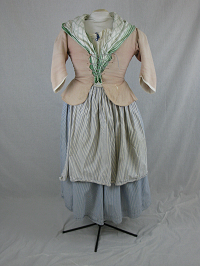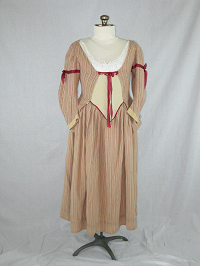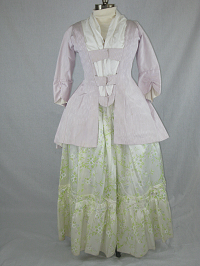
- Details
- Category: 18th Century
- Hits: 2808
1770s
This was the look for lower and middle class women in colonial America. The rose-colored fitted linen jacket has 3/4 length sleeves and is laced up the front with a cord. The kerchief is green-checked linen with deeply dyed edging. The blue/white apron, tied around the waist, is also of linen. Behind the apron is an ankle-length petticoat of blue linen. The finished width of this petticoat is 90-108 inches.
A brocade pocket is worn beneath the petticoat. It was an accessory, and hung from a cord tied around the waist. If you ever wondered how "Lucy Locket" of nursery rhyme fame lost her pocket, it's likely that her cord was accidentally untied or broken.
The linen shift is the foundation of this, and most, outfits of this period. It was worn as both underwear and nightgown.
Click photo for detailed views.
- Details
- Category: 18th Century
- Hits: 2852
1782-1790
This striped linen short gown is worn over a striped petticoat. The gown has festoon-like sections in the rear, which is held up by a rump ruffle. To further emphasize the front interest, a large kerchief was often added, puffed under the chin to achieve a pouter pigeon effect. This kerchief was usually of gauze. The shaped gown is tied over the kerchief at the bosom which allows the gown to flow open to reveal the corset. The full-length sleeve is fitted by silk ribbon. Petticoats were sometimes constructed with pleats to be left down as the person grew taller or as the skirt bottom became frayed. In Paris, ladies old and young wore pads behind to change the silhouette to a front-back interest, as was popular in the late 1780s and early 1790s.
Click photo for detailed views.
- Details
- Category: 18th Century
- Hits: 3364
1765-75
The pet en l’air was a short, open jacket intended to be worn at home, perhaps as a lady spent a morning writing letters before dressing for the day. This reproduced gown of orchid-colored watered silk would be worn by a woman of the “better sort” of Philadelphia just prior to the American Revolution. The gown was sometimes called a French jacket. The original French meaning of pet-en-l'air is opening, sometimes interpreted as peek-a-boo. The complicated outfit made it impossible for a woman to dress herself, so only someone with the resources to hire a maid could wear this elegant gown.
The jacket is lined with white cotton, except the pleats in the back. Beneath the pleats there are laces to make the bodice fit more closely to the figure. A sheer kerchief frames the neck and backs the tablier (apron-like) front which is fastened with concealed hooks. The sack-backed jacket is worn over a floral silk petticoat. Both have slits through which she has access to her pockets beneath. The pocket was tied to a string that went around the waist. Lucy Locket of nursery rhyme fame lost her pocket because her string came untied. During the 18th century petticoats were made to be seen and didn't become undergarments until the 1820s. A large hat covered the extreme hairdo.
About the waist is a ribbon girdle from which hangs a chatelaine. This kept necessities such as needles, pins, and perfume at her fingertips. Other items were carried in her pocket. A cap and hat were essential (not included in photo).
Hoops, often of whalebone, helped achieve the popular "wide side-to-side" silhouette by extending the petticoat out on the left and right side. In the late 1770s, the hoops had become smaller, which made going through doorways easier. A lady must stand tall and straight; to help her, she wore stays or a corset. These are stiffened with metal and bone and laced tightly.
Click photo for detailed views.
Additional sources:
https://brocadegoddess.wordpress.com/pet-en-lair/
http://fransewing.blogspot.com/2013/11/18th-century-jacket-pet-en-lair.html
Page 4 of 4



